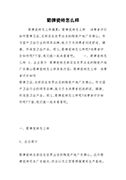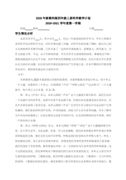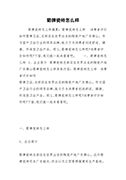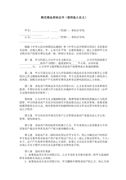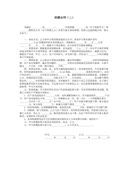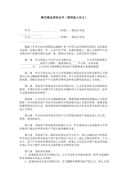Unit 4 Food(精选2篇)七年级英语教案
Unit 4 Food(精选2篇)
Unit 4 Food 篇1
unit 4 food
重点短语及句子:
1.be hungry/ be full 饥饿/饱
2.a lot of energy 许多能 量
3.walk to = go to…on foot 走到……地方去
4.many times a day 一天多次
5.what is your favourite food? 你最喜欢的食品是什么?
=what food do you like best?
6. want to do sth./ want to be 想要干某事/想成为
7. get tired 感到疲劳
8.need sb. to do sth. 需要……做某事
9.it is + adj. + for sb. to do sth. 对某人来说做某事是……
9.change the diet 改变饮食习惯
11. be good for sb. 对某人有好处
12. eat/ have sth. for breakfast/ supper/ lunch早餐/午餐/晚餐吃……
13. not…any mo re 不再……
14. chat with sb. 与某人交谈
15. twice a week/ once a month 一周两次/一月一次
1 6. fast food/ home cooking 快餐/家常菜
17. a health y meal 健康餐
18. how often 多久一次
19. cook healthy food 烹调健康食品
20. too much sugar 太多的糖
21. the get fit club 健身俱乐部
22. go roller skating 去滑冰
23. a packet of salt 一袋盐
24. fruit and vegetables 水果和蔬菜
25. feel much better 感觉好多了
26.a glass of/ a bowl of/ a cup of/ a kilo of/ a packet of一杯/一碗/一杯/一公斤/一包….
27. be important for sb. 对某人来说重要
29.would like to do sth. 想/愿意做某事
30.be importa nt to do sth. 做某事重要
31watch less tv 少看电视
32.feel well/ healthy 感觉好/健康
33.good luck to sb. 祝某人好运
34.be careful with sth. 小心某物
35.keep fit=stay/keep healthy 保持健康
36.healthy eating 健康饮食
37.have good health=be in good health=be healthy/fit身体健康
38.do some exercise=take some exercise 锻炼
39.different kinds of… 不同种类的/各种各样的
40.exercise more=do/take more exercise 多锻炼
41.on the tree/ in the tree 在树上
42. plan to do sth.=make a plan to do sth. 计划做某事
43.more than=over 多于,超过
语法点拨:
一、可数名词复数变化规则
most nouns +s a cake→ cakes
nouns ending in a consonant + y - y+ies a story→ stories
nouns ending in s,sh,ch or x + es a glass→glasses
a wish→wishes
a watch →watches
a box → boxes
nouns ending in o +s or +es a radio→radios
a potato→potatoes
a mango→mangoes
nouns ending in f or fe - f or –fe
- +ves a shelf→shelves
a knife→knives
some other nouns man→men
woman→women
foot→feet
tooth→teeth
sheep→sheep
fish→ fish
chinese→chinese
二、there be 的用法
be的形式由后面的名 词决定,就近原则。
there_________a book and two pens on the desk. (be)
there __________ two glasses of milk and a cup of tea in the fridge.(be)
there be 的时态:
一般现在时 there is/are ……
一般过去时 there was/were……
现在完成时 there have/has been……
一般将来时 there will/be going to be……
巩固练习:
一、 根据句意、首字母或中英文提示写出单词
1. there are a lot of old _________ (工厂) in our city.
2. my mother often _________(买) me some useful stationery when i was at school.
3. i think the ______ ___ (第五) lesson is the most difficult of all.
4. i’m hungry and i feel like e________(have) something.
5. a hea lthy d________ is very important for everyone.
6. he listens carefully in class. he _________(从不) talks in class.
7. my parents grow some v__________ (蔬菜) in the field.
8. you look t_________ (累). you’d better have a rest.
9. maths is my f_________ (like…best) subject.
10. the shoes are too big, so i’d like to try a_________ pair.
二、 用所给词的适当形式填空
1.—do you want to learn how to cook healthy and ____________ (taste) food?
-- of course.
2. there are many _________ (mango) in the basket.
3. tom is the ________ (two) to come to the classroom today.
4.the film a world without thieves is worth _________ (see).
5. my bike is broken and it needs __________ (repair).
6.there are many ________________ (woman teacher) in our school.
7.it is important for a dancer __________ (be) healthy.
8.how _______(many) ice cream is there in the bottle ?
9. our history teacher often tells us some interesting s_________ in our classes.
10.you are not fit, and you should change your l_________ .
三、 单项选择
( )1.if you finish your homework, you_ _______ stay here.
a. don’t need b. needs to c. needn’t d. n eedn’t to
( )2.--________ do you write to your parents?
-- every week.
a. how l ong b. how often c. how d. how soon
( )3.we’ve never been there before, _______ ?
a. haven’t we b. have you c. have we d. haven’t you
( )4.swimming in the pool with friends________ very interesting.
a. has b. have c. is d. are
( )5.—must i finish the work today ?
-- no, you_______. you ______ finish it tomorrow.
a. mustn’t; must b. needn’t ; may c. can’t ; may
( )6.-- good luck with your new die t.
-- ______ .
a. no, thanks b. thanks c. that’s all right d. that’s ok
( )7.—do you like ________ ?
-- no. i prefer rose, the colour of yo ur dress.
a. orange b. oranges c. carrot d. carrots
( )8. to keep healthy, we should eat more vegetables and less _____ .
a. meat b. food c. wine d. drink
( )9. –what do you have _______ in the morning?
-- i always eat an apple.
a. as breakfast b. for a breakfast c. for breakfast d. like a breakfast
( )10. – where can’t you see the sign‘business hours 8.00-18.00’?
- _________ .
a. in a library b. in a shop c. in a bank d. in a school
四、 根据汉语完成句子
1. 锻炼对你的健康有好处。
_________ is good _________ your_________ .
2. 他真够幸运的,通过了考试。
he was _________ _________ _________ pass the exam.
3. 我也喜欢玩电脑游戏并且在网上跟朋友聊天。
i also like _________ computer games and _________ _________ my friends on the internet.
4. kitty对她的饮食很小心,因为她想保持健康。
kitty is _________ _________ her diet because she wants to be______ ___ .
5. 你每天晚上看多少电视啊?
_________ _________ tv do you watch every night ?
Unit 4 Food 篇2
unit 4 food
grammar
一、年级:七年级
二、教学内容:7a unit 4 food
三、课型: grammar
四、教学目标
1.知识目标
1) 词汇:本课时的四会单词
2) 词组: a packet of, a kilo of, too much, play badminton
3) 语法: 频率副词的使用、可数名词和不可数名词的区分和使用、there be句型的基本结构。
2. 能力目标
能运用频率副词、可数名词和不可数名词、there be 句型谈论各自的日常饮食和生活方式。
五、教学重难点
识别并使用频率副词、识别并使用可数名词和不可数名词、包括规则变化和不规则变化、正确使用量词修饰不可数名词、掌握there be句型。
part one adverbs of frequency
step 1 lead-in
t:hi,everyone! here are some photos of my family. please look at them.
my aunt cleans the room every day. she always does the cleaning.
my uncle goes to the singing club at least (至少) five times a week. he usually sings songs after work.
my cousin loves drawing. he often draws pictures in the park.
sometimes he needs to go to the library to look for some information.
he is good at japanese. he seldom fails (失败) in the exam.
my cousin is a good boy. he never plays tricks on his dad.
step 2 explaining the grammar rules
t: please read the rules of grammar a on page 64 and answer the question.
what can adverbs of frequency tell us?
s: adverbs of frequency tell you how often things happen.
step 3 practicing the grammar
t:ask and answer about the following questions:
what do you never/ seldom/ sometimes/ often/ usually/ always eat and drink?
s: i… eat…./ i…drink….
what do you never/ seldom/ sometimes/ often/ usually/ always do?
s: i …do….
t: please finish the exercise on p64.
s: 1. often 2. seldom
3. usually 4. never
5. always 6. sometimes
part two countable and uncountable nouns
step 4 lead-in
t: please look at the pictures and tell us what it is.
s: a pig, two pigs, a dog, two dogs, a banana, many bananas, an orange, two oranges, a tomato, three tomatoes, a potato, some potatoes, a box, eight boxes, a watch, two watches, a cat, four cats, a bird, two birds
step 5 explaining the rules
t: countable nouns
1. a countable noun refers to something we can count.
2. we use ‘a’ or ‘an’ before a singular countable noun. if the noun starts with a vowel sound, we use ‘an’.
3. to form the plural form of most countable nouns, we add ‘-s’ to the singular form. however, there are some exceptions. please look at the rules on page 65.
4. an uncountable noun refers to something we can’t count, such as bread, water, chicken, ham, juice and so on.
5. we can also use nouns in front of uncountable nouns to show their amounts.
step 6 lead-in
t: here are some other pictures. can you describe them using a phrase?
s: a cup of tea, two cups of tea, a glass of water, two glasses of water, a bottle of coke, six bottles of coke, a packet of salt, two packets of salt.
t: what can you see in your fridge?
s: i can see…in my fridge.
step 7 pracicing the grammar
t: complete the conversation on p66.
s: 1. chicken 2. bag 3. rice 4. packet 5. salt 6. vegetable
7. carrots 8. potatoes 9. mangoes 10. apple 11. coke 12. cartons
13. milk
t: go on doing the exercises on p66.
put the things they are going to buy into the correct categories in the table below .
s: countable nouns (singular): bag, packet, apple
countable nouns (plural): carrots, potatoes, vegetables, mangoes, cartons
uncountable nouns: chicken, rice, salt, milk, coke
part three using ‘there be’
step 8 lead-in
t:please look at the picture and describe it using ‘there is…”, “there are…”.
s: there is…./ there are….
t: there are many things in it. are there any…in it?/ there is nothing in it.
is there a/ an… in it?
step 9 practicing the grammar
t: let’s make a guessing game.
there is some food and fruit in the bag. can you guess what’s in it?
s: is there/ are there… in it?
t: yes./no.
step 10 explaining the grammar rules
t: we use ‘there be’ to show that something exists. we use ‘there is’ before a singular noun or an uncountable noun. we use ‘there are’ before a plural noun.
t: please do part c on page 67.
s: 1. is there 2. there is
3. there is 4. there isn’t
5. are there 6. there are
7. there are 8. there are
9. there is 10. is there
11. there isn’t
part four homework
1. revise the grammar rules.
2. do some more exercises.
can you help them find the right family?
apple mango cup plate
egg dish salt beef
bread cake hamburger coke
bowl juice meat milk
rice tomato
translate the phrases into english
十一个婴儿
九个男孩
四个班级
三杯茶
六头大象
五公斤牛肉
十八只猴子
七把小刀
说 明
本课时是7a 第四单元的语法课,内容是学习和运用频率副词、可数名词和不可数名词、there be句型。
本课时的内容比较多,尤其是可数名词、不可数名词及there be 句型这两部分的语法,学生理解起来比较困难。
在教学过程中,建议老师尽可能的多用直观教学法,结合学生的生活,为学生创设口头和笔头训练的情境。


